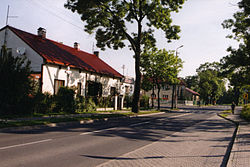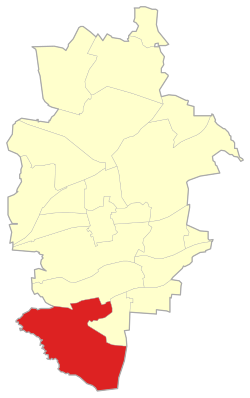
Silesia is a historical region of Central Europe that lies mostly within Poland, with small parts in the Czech Republic and Germany. Its area is approximately 40,000 km2 (15,400 sq mi), and the population is estimated at 8,000,000. Silesia is split into two main subregions, Lower Silesia in the west and Upper Silesia in the east. Silesia has a diverse culture, including architecture, costumes, cuisine, traditions, and the Silesian language. The largest city of the region is Wrocław.

Silesian Voivodeship is a voivodeship, or province, in southern Poland centered on the historic region known as Upper Silesia, with Katowice serving as its capital.

Zabrze is an industrial city in Silesia in southern Poland, near Katowice. It lies in the western part of the Metropolis GZM, a metropolis with a population of around 2 million. It is in the Silesian Highlands, on the Bytomka River, a tributary of the Oder.

Gliwice is a city in Upper Silesia, in southern Poland. The city is located in the Silesian Highlands, on the Kłodnica river. It lies approximately 25 km west from Katowice, the regional capital of the Silesian Voivodeship.

Bytom is a city in Upper Silesia, in southern Poland. Located in the Silesian Voivodeship of Poland, the city is 7 km northwest of Katowice, the regional capital.

Chorzów is a city in the Silesia region of southern Poland, near Katowice. Chorzów is one of the central cities of the Metropolis GZM – a metropolis with a population of 2 million. It is located in the Silesian Highlands, on the Rawa River.

Ruda Śląska is a city in Silesia in southern Poland, near Katowice. It is a city in the Metropolis GZM, a metropolis with a population of two million. It is in the Silesian Highlands, on the Kłodnica River.

Upper Silesia is the southeastern part of the historical and geographical region of Silesia, located today mostly in Poland, with small parts in the Czech Republic. The area is predominantly known for its heavy industry.
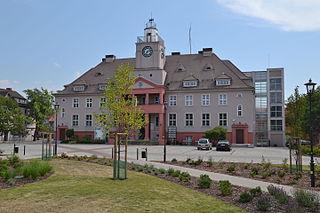
Kędzierzyn-Koźle is a city in southern Poland, the administrative center of Kędzierzyn-Koźle County. With 58,899 inhabitants as of 2021, it is the second most-populous city in the Opole Voivodeship.
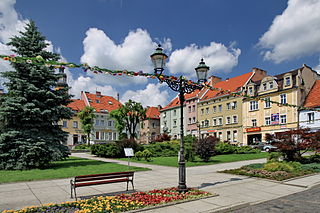
Wodzisław Śląski is a city in Silesian Voivodeship, southern Poland with 47,992 inhabitants (2019). It is the seat of Wodzisław County.
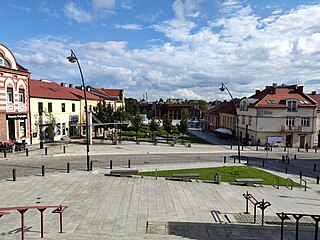
Jaworzno is a city in southern Poland, near Katowice. It lies in the Silesian Highlands, on the Przemsza river. Jaworzno belongs to Lesser Poland and despite belonging to Silesian Voivodeship since 1999, Jaworzno is not part of Silesia. The city is situated in the Silesian Voivodeship since its formation in 1999, previously (1975–1999) it was in Katowice Voivodeship. Jaworzno is one of the cities of the 2,7 million conurbation – Katowice urban area and within a greater Katowice-Ostrava metropolitan area populated by about 5,294,000 people. The population of the city is 89,350 (2021).

Silesian Trams is one of the largest tram systems in the world and the largest and longest tram system in Poland, located entirely within the Silesian Voivodeship. Started as a part of the German Empire in 1894, the system currently has 677 stops across 29 lines and serves the region’s population inhabited by more than two million people. Silesian Trams is at the heart of a region known for its dense historical and current industrialisation.

Giszowiec is an eastern district of the city of Katowice, created as a coal miners' settlement in 1907. Initially consisting of about 3,300 miners and their families, the district's population have grown over the years to over 18,000. Although Giszowiec's architectural originality suffered major damages in the 1970s and 1980s due to large scale urbanization, its early unique character can be still felt in the surviving miners' housings, the marketplace, numerous individual buildings and structures, as well as the relatively well preserved general design of a "Garden city".

The Metropolis GZM is a metropolitan association composed of 41 contiguous municipalities in the Silesian Voivodeship of Poland. The seat of the metropolitan council is Katowice, the largest member city and the voivodeship capital. With a population of over 2 million, the core of the Metropolis GZM is one of the largest urban areas in the European Union. The area of the metropolis largely coincides with the metropolitan area of the Katowice urban area, which is a part of the wider cross-border Katowice-Ostrava metropolitan area, the latter with a population of 5–5.3 million people.

Wojkowice is a small town in województwo śląskie, located in so-called Zagłębie Dąbrowskie in southern Poland, near Katowice. Wojkowice is located in the Silesian Highlands, on the Brynica river, and historically belongs to Lesser Poland. Its name comes from ancient Polish given name Wojek, which might have been a diminutive of Wojslaw. Several other locations in Poland have been named in a similar fashion – Wojslawice, Wojkowo, Wojkow, Wojkowa.

Libiąż is a town in Chrzanów County, Lesser Poland Voivodeship, Poland, with 17,671 inhabitants (2004).

Drogowa Trasa Średnicowa is a controlled-access highway in Silesian Voivodeship, Poland. The DTŚ is entirely a dual carriageway with a minimum of 3 lanes in each direction. It is one of the most important roads of the Upper Silesian Industrial Region.

The Gliwice Canal is a canal connecting the Oder (Odra) River to the city of Gliwice in the Silesian Voivodeship, Poland. Also known as the Upper Silesian Canal, it was built from 1935 to 1939 and replaced the Kłodnicki Canal.
The Kłodnicki Canal is a canal along the Kłodnica River in Upper Silesia, Poland between the Oder River and Gliwice. Constructed when the territory was part of Prussian Silesia, it was originally known as the Klodnitz Canal.

Halemba is a district in the south-west of Ruda Śląska, Silesian Voivodeship, southern Poland. It lies on the river Kłodnica, right tritubary of Odra. It has an area of 19.6 km2 and in 2006 it was inhabited by 26,080 people.
